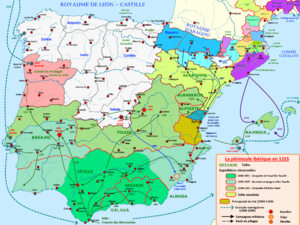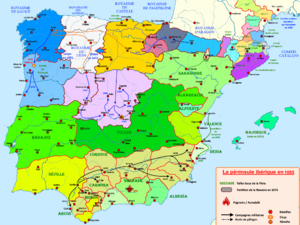Hammudid dynasty facts for kids
The Hammudid dynasty (pronounced Ham-MOO-did) was a powerful Arab family that ruled parts of al-Andalus (which is now Spain and Portugal) a long time ago. They were in charge during a period called the Taifas, from 1016 to 1057.
The Hammudids controlled important cities like Málaga, Ceuta, and Algeciras. The first three leaders of this family even called themselves "caliphs" in Córdoba. A caliph was like a supreme ruler in the Islamic world. They were competing with the last rulers of the Umayyad dynasty. The Hammudid dynasty ended when their lands were taken over by the Zirid dynasty in 1057. They are special because they were the only known Shi'a Muslim ruling family in al-Andalus.
Contents
The Hammudid Family's Rise to Power
The Hammudid family got its name from an ancestor named Hammud. This family was related to Idris ibn Abdallah, who founded the Idrisid dynasty. They were also descendants of Hasan, who was the grandson of the Islamic prophet, Muhammad.
When a ruler named Sulayman ibn al-Hakam gave land in al-Andalus to his Berber allies, two Hammudid family members became governors. They were put in charge of Algeciras, Ceuta, and Tangier. This gave the Hammudids control over the important sea traffic through the Straits of Gibraltar. Suddenly, they became very powerful.
In 1016, the Hammudid governor of Ceuta, Ali ibn Hammud al-Nasir, marched to Córdoba. He claimed to be acting for the previous ruler, Hicham II, who had been removed from power. When he reached Córdoba, Ali was crowned Caliph.
By 1056, the last Hammudid Caliph was removed from power. They lost control of Málaga to the Zirid dynasty from Granada. The Zirids had actually been big supporters of the Hammudids before this. After losing Málaga, the Hammudi family had to move to Ceuta.
Early History of the Hammudids
The Hammudid family's story began when the Umayyad Caliphate's army, led by a vizier named Almanzor, defeated the Idrisid dynasty in Morocco. The Idrisids were scattered, hiding among different Berber tribes. Hammud, the ancestor of the Hammudid dynasty, was part of these Berber groups that Almanzor had recruited.
Hammud had two sons, `Alī ben Hammūd and Al-Qāsīm. They became important leaders among the Berber troops. These troops helped to overthrow the caliph Hichām and put his distant relative Sulayman in power in 1013.
The new caliph, Sulayman, was called Al-Musta'īn. But he was really just a puppet ruler, with Almanzor holding all the real power. Sulayman gave important positions to those who helped him. `Alī ben Hammūd was given control of Tangier and northern Morocco. His older brother, Al-Qāsīm al-Ma'mūn, received Algeciras.
`Alī ben Hammūd Becomes Caliph
At first, `Alī ben Hammūd was loyal to the caliph. But then he rebelled and moved to Spain. He took advantage of the caliph's weakness and declared himself independent. He quickly took control of Malaga.
`Alī then marched towards Cordoba with a large army, joined by his brother Al-Qāsīm al-Ma'mūn. Caliph Sulayman was quickly defeated, captured, and then killed. On July 7, 1016, `Alī declared himself caliph, taking the title Al-Nāsir, meaning "The Victorious."
Al-Qāsīm al-Ma’mūn Takes Over
`Alī became unpopular, and on April 17, 1018, he was murdered. His brother, al-Qāsīm, then became caliph. He took the title al-Ma'mūn, meaning "He who is trusted." This happened after `Abd al-Rahman tried briefly to bring back the Umayyad dynasty.
However, al-Qāsīm was soon overthrown by his nephew Yahyā in 1021. Yahyā was the son of `Alī ben Hammūd. Yahyā had been given control of Tangier by his father. He crossed into Spain with his Ghomaras troops to challenge his uncle for power.
Yahyā al-Mu`talī's Reign
In 1018, after his father Ali bin Hammud al-Nasir died, Yahyā's uncle Al-Qāsīm became caliph. Yahyā did not agree with this decision.
The conflict between the two relatives continued. Yahyā ordered his uncle, who was held captive in Malaga, to be killed. Yahyā suspected his uncle was planning to take power back. Yahyā then ruled over Malaga, Algeciras, and Ceuta.
However, in Cordoba, the people chose `Abd al-Rahman as their caliph. `Abd al-Rahman was the brother of the Umayyad Muhammad Al-Mahdī. `Abd al-Rahman took the title Al-Mustazhir. Yahyā was no longer the caliph, but he continued to rule in Malaga and Algeciras.
Towards the end of 1035, Yahyā felt strong enough to get revenge on the Cadi (a judge) of Seville. He went to lay siege to that city. During this quick military campaign, Yahyā was killed in 1035.
The Later Hammudite Emirs
The news of Yahyā's death brought great joy in Seville and Cordoba. The cadi no longer had to fear the Hammudites. Idrīs, Yahyā's brother, was declared caliph in Malaga. He took the name Al-Muta'ayyid. At the same time, his cousin was declared caliph in Algeciras, taking the name Al-Mahdī.
During this time, the power of the Zirid rulers of Granada grew. The Zirids were technically under the Hammudites. Their power increased thanks to the smart leadership of their Jewish vizier, Samuel ibn Nagrela.
Idrīs died from an illness in 1039.
Two people wanted to be the next ruler: Yahyā al-Qa`im, son of Idrīs, and his cousin Al-Hassan al-Mustansī, son of Yahyā al-Mu`talī. Al-Hassan was in Africa. When his ships appeared near Malaga, Yahyā al-Qa`im ran away. Hasan pretended to forgive him but killed him soon after in 1040. Al-Hasan was then poisoned by his wife in 1043. She was the sister of the Yahyā al-Qa`im he had killed, and she was getting revenge for her brother.
After this, Nadja, a eunuch vizier who had helped Al-Hasan gain power, tried to take control himself. He set out to capture Algeciras, which was held by Muhammad al-Mahdī. Muhammad was the son of al-Qāsīm al-Mā'mūn. Nadja was killed during this campaign on February 5, 1043.
Idrīs II al-`Alī, Al-Hasan's brother, took over in Malaga. Idrīs II was a peaceful ruler, but some people thought he was too weak. Muhammad, a cousin of Idrīs II, was pushed into power by the African military in 1047. This new ruler was very different from Idrīs II. Those who thought Idrīs was too weak now found Muhammad too strict.
Another plan was made to bring Idrīs back and remove Muhammad. However, Idrīs had to escape to Africa. There, he was welcomed by the Berber governors of Tangier and Ceuta. These governors feared that Idrīs might try to take their lands. So, they sent him back to Spain, while still pretending to be loyal to him. Idrīs found safety in Ronda.
The unhappy people of Malaga asked for help from Badis ben Habus, the Zirid ruler of Granada since 1038. He took Malaga in 1053. The throne was then taken by Muhammad al-Mahdī al-Mu`tarim, son of Idrīs I al-Muta'ayyid, in 1047. Then, Idrīs III al-Muwaffaq, son of Yahya II al-Qa`im, ruled briefly in 1053.
Idrīs II al-`Alī was finally put back in power in 1054. He was very old by then and died in 1055. Muhammad al-Musta`lī, another son of Idrīs I al-Muta'ayyid, became ruler. But it was Badis who took complete control of Malaga in 1058. This event marked the end of the Hammudite dynasty.
See also
 In Spanish: Dinastía Hammudí para niños
In Spanish: Dinastía Hammudí para niños





